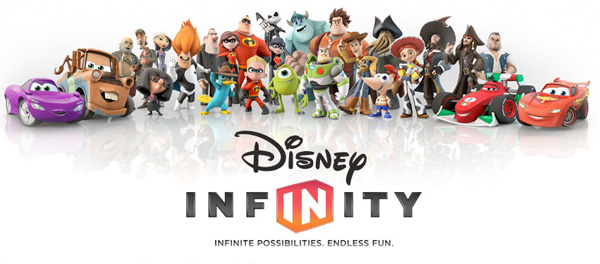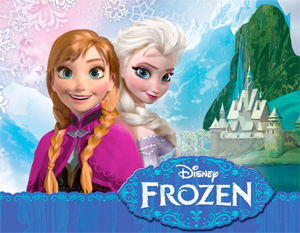Disney Infinity: A Promotional Platform [Part Two]
 As mentioned in yesterday’s post, it would be wrong to suggest Disney Infinity signals a step away from licensed tie-in titles from Disney Interactive. Indeed, of the five “playsets”—6-8 hour open-world games based exclusively in a single Disney franchise—either included in the Starter Pack or available sold separately at a cost of $34.99, two are based on films released this summer: June’s Monsters University, and July’s The Lone Ranger. Disney Infinity was initially intended to be released in June just as those films were entering theaters, although subsequent delays mean the “tie-in” play sets are available after both films have largely completed their respective box office runs.
As mentioned in yesterday’s post, it would be wrong to suggest Disney Infinity signals a step away from licensed tie-in titles from Disney Interactive. Indeed, of the five “playsets”—6-8 hour open-world games based exclusively in a single Disney franchise—either included in the Starter Pack or available sold separately at a cost of $34.99, two are based on films released this summer: June’s Monsters University, and July’s The Lone Ranger. Disney Infinity was initially intended to be released in June just as those films were entering theaters, although subsequent delays mean the “tie-in” play sets are available after both films have largely completed their respective box office runs.
The Lone Ranger play set, one of the two sold separately from the Starter Pack, functions more or less like any other licensed game tied to a film’s release. The play set was supposed to introduce the film’s world and its characters to audiences ahead of the film’s release, but instead—because of the delay, which was allegedly to appease retailers who wanted a release closer to the holiday season—arrives as a monument to a box office failure. While the play set was in development too long in advance to scrap entirely, the Lone Ranger and Tonto are absent from some of the promotional images surrounding the game’s release, and it is the only play set for which only two figures were produced (with fellow standalone play set, Cars, earning two extra figures beyond those included with the play set).

While not absent from all promotions for the film, this common piece of promotional material—found, among other places, on the official Infinity website—omits The Lone Ranger and Tonto.
Like any case of licensed content tied to a failed franchise, the Lone Ranger play set has a degree of novelty attached to it—after seeing I had purchased the play set, a colleague commented that it would either be worth a lot or nothing at all in thirty years. However, if the film had been successful, the play set would have offered a valuable case study for the future of Disney Infinity as a promotional platform. Would filmgoers have bought into the Infinity platform solely to access licensed content tied to a box office success, spending—at MSRP—$110 for the privilege? Would Disney Infinity gamers hungry for more content have picked up the play set and—provided the game was released during its planned June window—potentially gained greater interest in the film?
These questions are integral to the future productivity of Disney Infinity to Disney. Moving their licensed content onto the Infinity platform to help build interest in its release is certainly one of Disney’s goals, although one that is more likely to work with pre-existing franchises like Cars than with something entirely new. Disney’s selection of play sets to include with the Starter Pack—The Incredibles, Pirates of the Caribbean, and Monsters University—demonstrate a preference for franchises that appeal to both adults and kids, heavily relying on Pixar’s track record and largely obscuring Disney Animation Studios’ own animated output (although Wreck-it-Ralph figures are coming, and myriad Disney projects are represented in items available in the game’s Toy Box mode). These Starter Pack franchises are being used as gateways, which can then build an install base large enough that when Disney releases Frozen in November it will have figures available on store shelves ready to meet the demands of kids who’ve seen the movie.
 However, Disney’s plans for Frozen in Infinity capture the difficulty of developing a new franchise through a still nascent platform. Although figures for Anna and Elsa are going to be made available, along with “power discs” offering special tools for the game’s Toy Box mode, there will be no open-world play set tied to the film. Instead, Disney will once again rely on an existing franchise to add value to the platform ahead of the Christmas holidays, with a “Toy Story in Space” play set launching in October alongside a collection of new stand-alone figures. And since players can only use figures from a particular franchise in a play set, the Anna and Elsa figures will only work in the sandbox Toy Box mode, with only a single character-specific mission built for each of the two characters as opposed to an entire “game.”
However, Disney’s plans for Frozen in Infinity capture the difficulty of developing a new franchise through a still nascent platform. Although figures for Anna and Elsa are going to be made available, along with “power discs” offering special tools for the game’s Toy Box mode, there will be no open-world play set tied to the film. Instead, Disney will once again rely on an existing franchise to add value to the platform ahead of the Christmas holidays, with a “Toy Story in Space” play set launching in October alongside a collection of new stand-alone figures. And since players can only use figures from a particular franchise in a play set, the Anna and Elsa figures will only work in the sandbox Toy Box mode, with only a single character-specific mission built for each of the two characters as opposed to an entire “game.”
Although this may simply be a reality of the timing of Frozen’s release relative to the platform’s development, it signals that thinking about Disney Infinity as a replacement for licensed tie-ins—as opposed to the creative revolution they claim—may still be overestimating Disney’s plans. Rather, it may instead offer a way for them to avoid developing a traditional console and/or handheld title for particular films but nonetheless give those films a presence in the space of console and handheld video games. The company may otherwise be content to serve fans in the space of browser and mobile gaming, where development is cheaper and where Disney is having success with developing new franchises like Where’s My Water alongside derivative mobile titles.
 This plan would likely serve Disney’s financial and promotional goals for Frozen, but it also means the value the franchise is adding to Infinity is limited. Although the two Frozen figures will—as pictured—be sold bundled with the two power discs (which are in other instances purchased in packages of two for $4.99) to commemorate the film’s opening, that package offers minimal new “content,” primarily offering aesthetic changes in Toy Box mode. With no future play sets planned beyond Toy Story, the Infinity platform functions not just as a new way to released licensed content but also a way for Disney to scale back its licensed game development while nonetheless ensuring presence—if not substantial presence—on consoles in the future. The question becomes whether they’re offering enough value in these standalone licensed products for them to serve as a promotional platform for either Infinity or the films in question, a question I will explore further in the final post of this series, “Behind the P(l)aywall“. See also the first post, “A Low-Risk Revolution.”
This plan would likely serve Disney’s financial and promotional goals for Frozen, but it also means the value the franchise is adding to Infinity is limited. Although the two Frozen figures will—as pictured—be sold bundled with the two power discs (which are in other instances purchased in packages of two for $4.99) to commemorate the film’s opening, that package offers minimal new “content,” primarily offering aesthetic changes in Toy Box mode. With no future play sets planned beyond Toy Story, the Infinity platform functions not just as a new way to released licensed content but also a way for Disney to scale back its licensed game development while nonetheless ensuring presence—if not substantial presence—on consoles in the future. The question becomes whether they’re offering enough value in these standalone licensed products for them to serve as a promotional platform for either Infinity or the films in question, a question I will explore further in the final post of this series, “Behind the P(l)aywall“. See also the first post, “A Low-Risk Revolution.”


